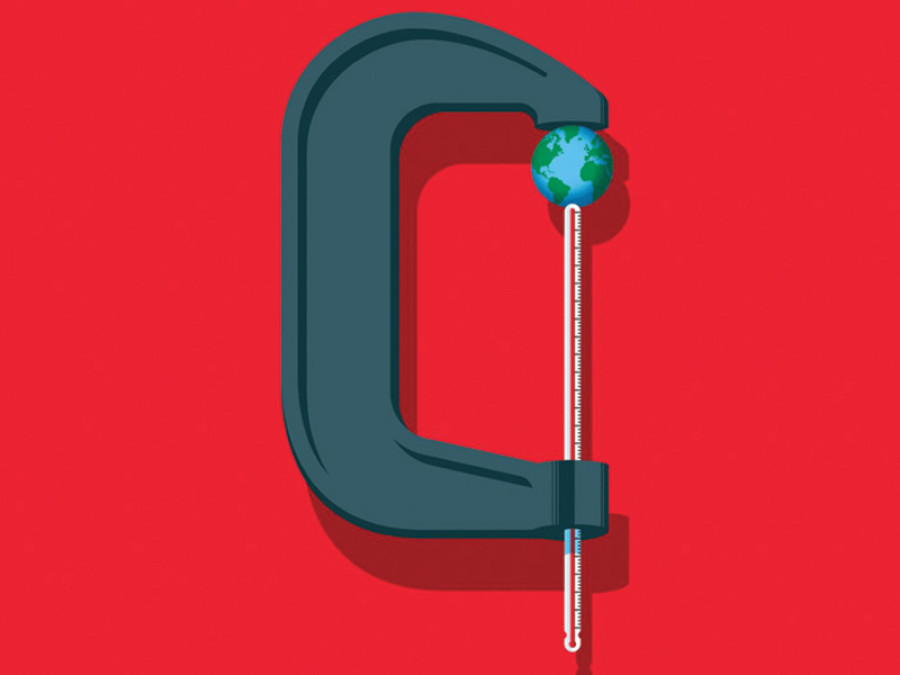Opinion
Rethinking governance
Stories of Nepali families devastated by earthquakes, floods, droughts, and other hazards will proliferate in the future
Ajaya Dixit
On April 22, high-level government representatives from about 55 countries participated in a signing ceremony held in New York as a first step in implementing the Paris agreement. The agreement aims to “[hold] the increase in the global average temperature to well below 2°C above the pre-industrial level and to pursue efforts to limit the temperature increase to 1.5°C above the pre-industrial level.”
This commitment also aims to reduce the risks and impacts of global climate change and achieve the goals of reducing emissions, keeping the rise in average global temperatures below the stated threshold, and preventing climate change from hurting the citizens of countries like Nepal, especially the poor and disadvantaged communities. To avoid this possibility, effective adaptive solutions are needed, and fast.
Erratic climate system
Adaptation is fundamental to the long-term well-being of those who are vulnerable to climate change risks. Even if individual countries meet their intended emission reduction targets, global and local climate systems will continue to become erratic. The fact of the matter is, as erratic climate trends make abundantly clear, climate change is already here even if science still does not allow the direct attribution of a specific local weather event to climate change. Nepalis, for example, are already suffering from extended dry seasons, droughts, depleting water sources and prolonged dry ambience creating conditions conducive for forest fires—all impacts have resulted in household water insecurity and aggravated household food problems. There have also been instances of freak hailstorms, which have completely damaged crops, and untimely and extreme floods, which have caused deaths and loss of assets and disrupted basic services. Such events have taken away jobs and livelihoods and interrupted the regular functioning of societies, governments, and businesses and will likely continue to do so in the future.
In many cases, marginalised communities use services from ecosystems such as clean water and air, forest products, flood buffering, soil fertility and crop fertilisation to autonomously adapt to climatic and other stresses. But these services are deteriorating fast; so is the ability of marginalised families to sustain their livelihoods. Technological innovations, access to additional finances, and support systems such as improved access to reliable information can help augment autonomous adaptive behaviour, but these things are not readily available to those who need them the most. Besides, even if they do have access to them, what can they do if the hydrological cycle does not bring water, the basic sustenance of ecosystem services, on time and in sufficient amounts? The ongoing drought demonstrates the helplessness of even the technologically advanced, wealthy, and well-serviced.
What can be done if the hydrological cycle fails to bring water is a very serious question. Another key issue is the need to backstop local institutions so that they can play an effective role in providing social security measures that help the vulnerable to deal with the impacts of both climatic and non-climatic shocks. Poor and otherwise excluded Nepalis simply do not have this sort of support. The country’s self-serving political order and desultory governance arrangement have meant that no government has been able to even conceptualise such support so that the impacts spawned by different hazards are minimised. The Gorkha earthquake, for example, required a creative, inclusive, and outside-of-the-box approach to assist victims in rebuilding a better future. Unfortunately, responses have been bureaucratic, tardy and lacking in empathy for the victims. In fact, the status quo is entrenched and the seeds that will stifle adaptation possibilities are becoming institutionalised.
Seeds of vulnerability
To enable potential victims to recover, rebuild better, and move on with their lives after experiencing disruptions from climate change-induced and other shocks, an innovative approach to governance is required. Understanding climate change vulnerabilities and designing appropriate solutions to deal with them require flexible and iterative processes that recognise the natural and social drivers of vulnerabilities. Strategies need to be contextualised to specific circumstances and local institutions must play a central role in adaptation efforts. Institutions must continually adopt new knowledge, adapt to changing political and social contexts, and maintain equity while extending services to affected families. Crafting such an approach, however, is fraught with philosophical challenges.
The changing nature of the hydrological cycle is one example. Our knowledge about the impact of climate change on water systems is based on the premise that the hydrological cycle is stationary, i.e. the basic statistical properties of its sub-processes, such as temperature and rainfall, remain constant over a period of 30 to 35 years. With this assumption, data on temperature, rainfall, humidity, stream-flow, and other climatic conditions are used as baselines to design, build, and operate systems to deliver drinking water, irrigation, electricity, flood reduction, and other services. These assumptions also guide the institutions that manage and govern the delivery of services provided by both ecological and human-built systems. Climate change, however, has introduced dynamism into the hydrological cycle, and its statistical properties are clearly not stationary, if indeed they ever were. Because of this constant flux, institutions and governance mechanisms based on the assumption that are static baseline conditions are likely to be ineffective.
The current approaches to governance regimes in almost all countries rest on the notions of bureaucratic rationality and legal certainty and assume that the historical past can predict future trends. Approaches cannot be ahistorical, yet while dealing with changing hydrological cycle, exclusive reliance on conventional ways will not effectively deliver in today’s world, which is experiencing a rapidly changing climate and many uncertainties about what is to come. The latest theories suggest that the best way to deal with uncertainties is building resilience and adaptive capacity which requires a governance approach based on iterative learning. Such an approach, however, seems incompatible with the rigid nature of the Nepali government bureaucracies. The question we must ask is: How do decision-makers reconcile the idea of flexibility with the notion of governmentality dominating the current public policy world? Any organisational design based on static premises is unsuitable in a milieu characterised by rapid political, social, and environmental changes.
Introducing iterative learning in Nepal seems close to impossible. The very idea of prioritising localised knowledge and sharing its insights with the decision-makers is an anathema. While the governments hold little motivation to change their strategies and prevent systemic vulnerabilities from getting institutionalised, donors and civil society actors consider adaptation as a time-bound project and not a process. The results are clear. In the future, stories of suffering Nepali families devastated by earthquakes, floods, droughts, and other hazards will proliferate. In the current scheme of things, increased hardship is inevitable for many, despite the commitments made on the last International Mother Earth Day in the headquarters of the United Nations.
Dixit is Executive Director of the Kathmandu based ISET-Nepal




 6.73°C Kathmandu
6.73°C Kathmandu












